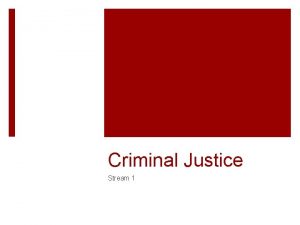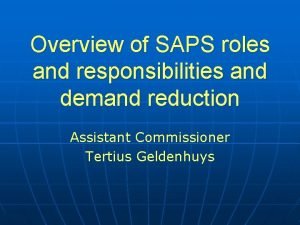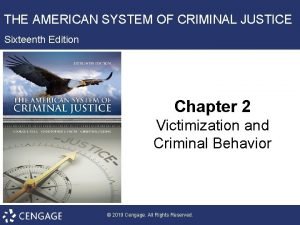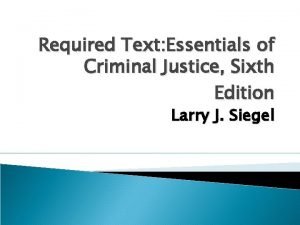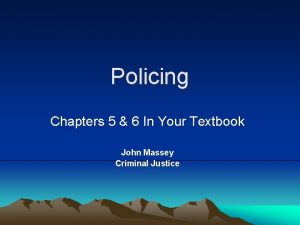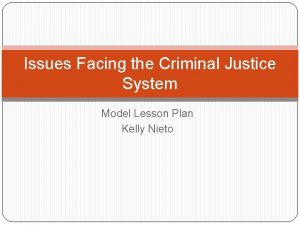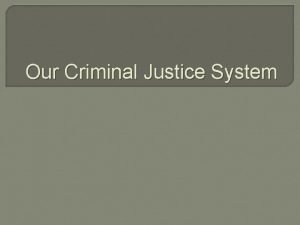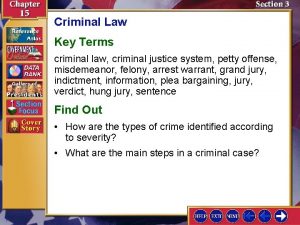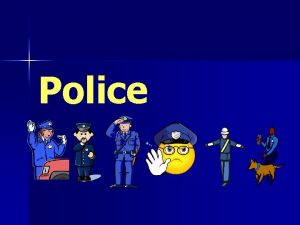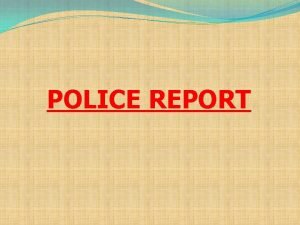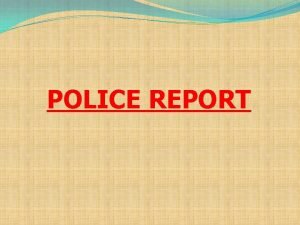Criminal Justice System Criminal Justice System Police Most










- Slides: 10

Criminal Justice System

Criminal Justice System • Police – Most immediate control over who is arrested for a criminal act – Police discretion • The power held by police officers to decide who is actually arrested – Racial profiling • The practice of assuming that non-white Americans are more likely to commit crime than white Americans

• How do police decide to make an arrest? – The seriousness of the offense – Wishes of the victim are taken into consideration – The attitude of the suspect is considered – If bystanders are present, the police are more likely to make an arrest – Police are more likely to arrest (and use force against) African Americans

Criminal Justice System • Courts – After an arrest, responsibility goes to the part of the court system – There is a two-fold process in the courts • A court determines guilt or innocence of a person in a trial • In the case of a guilty verdict, the court assigns a punishment

– More than 90% of all criminal cases are settled through plea bargaining – Plea bargaining • Process of legal negotiation that allows an accused person to plead guilty to a lesser charge in return for a lighter sentence – Plea bargaining helps reduce large caseloads, save on expensive and timeconsuming jury trials

Criminal Justice System • Corrections – Are made up of 3 sanctions • Imprisonment • Parole • Probation – Corrections are used to punish criminals

– The 3 sanctions serve 4 basic functions • Retribution – The punishing of a criminal serves as an act of revenge for the victim and society • Deterrence – Is intended to discourage offenders from committing future crimes and to make the rest of society think twice before breaking laws

• Rehabilitation – During the 1800’s, prisons emerged as places in which to reform criminals so that they could return to society as law-abiding citizens • Social Protection – By limiting the freedom of offenders, society prevents them from committing additional crimes. – In the case of the death penalty, the threat of an offender committing future criminal acts is eliminated.

Criminal Justice System • Does the corrections system work? • There are indications that this system doesn’t work. • Recidivism – The term for repeated criminal behavior • 68% of released prisoners will be charged with new crimes • 52% will return to prison within 3 years

Characteristics of federal arrestees booked by the U. S. Marshals Service, October 1, 2008–September 30, 2009 Arrestee characteristic Number Percent All arrestees Sex Male Female Race* White Black/African American Indian/Alaska Native Asian/Native Hawaiian/Other Pacific Islander Age Under 19 years 19– 20 21– 30 31– 40 Over 40 Citizenship U. S. citizen Non-U. S. citizen Note: Details may not sum to the total number of arrestees due to missing data. *Hispanic or Latino origin not available. Source: U. S. Marshals Service Prisoner Tracking System file, fiscal year 2009. 183, 986 100% 159, 842 24, 142 86. 9% 13. 1 144, 929 32, 872 2, 291 79. 6% 18. 1 1. 3 1, 883 1. 0 3, 680 9, 034 64, 108 50, 168 37, 143 2. 2% 5. 5 39. 1 30. 6 22. 6 71, 412 84, 640 45. 8% 54. 2
 Criminal justice stream
Criminal justice stream Arizona criminal justice information system
Arizona criminal justice information system Responsibilities and functions of saps
Responsibilities and functions of saps Criminal justice wedding cake
Criminal justice wedding cake The american system of criminal justice 16th edition
The american system of criminal justice 16th edition Mexico criminal justice system
Mexico criminal justice system Cjpp guelph
Cjpp guelph Pornography laws connecticut
Pornography laws connecticut The idea of a criminal justice nonsystem
The idea of a criminal justice nonsystem What is a grass eater in criminal justice
What is a grass eater in criminal justice Eighth amendment excessive bail
Eighth amendment excessive bail
